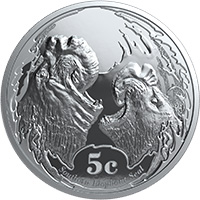South Africa has established a network of marine protected areas (MPAs) to help conserve marine biodiversity and support the sustainable use of its marine resources, including around its sub-Antarctic possessions, the Prince Edward Islands in the southern Indian Ocean in 2013 (click here).
The South African Mint has this year commemorated the establishment of the islands’ 180 000 km²-MPA by issuing the last of four annual MPA sets of sterling silver coins bearing the images of Southern Elephant Seals (nominally 5c), a Wandering Albatross (10c), Orcas or Killer Whales (20c) and King Penguins (50c).
The mint’s supporting texts for each coin follow, after being corrected for several factual errors:
50c (2 oz, sterling-silver)
The reverse of the 50c features the King Penguin Aptenodytes patagonicus, one of the four penguin species which breed on the islands. In 2008, there were approximately 2000 pairs on Prince Edward Island and about 65 000 pairs incubating eggs on Marion Island. The coin depicts an adult pair and their chick standing among a colony of King Penguins.
20c (1 oz, sterling-silver)
The Marion Island Killer Whale Programme was established as a dedicated research wing of the Marine Mammal Programme to observe, obtain tissue samples and track the Killer Whales Orcinus orca visiting the island’s rocky shores. Most of the research is done inshore due to the proximity of the visiting Killer Whales who feed on elephant seals, fur seals and penguins. About 60 individuals have been catalogued. The 20c (1 oz) shows two Killer Whales leaping from the sea.
10c (1/2 oz, sterling-silver)
The Prince Edward Islands support about 44% of the World’s Wandering Albatross Diomedea exulans population. An adult albatross landing in the ocean is shown on the 10c. It has a circumpolar range in the Southern Ocean and can travel great distances in search of food. Ranging from 2.5 m to 3.5 m, its wingspan is the largest of any bird, allowing it to remain airborne for many hours without having to flap its wings.
5c (1/4 oz, sterling-silver)
The Southern Elephant Seal Mirounga leonina featured on the reverse of the 5c spends most of its life out at sea. These seals haul themselves on to land during the breeding season or when they moult in summer and autumn. The males are instantly recognisable by their large, inflatable probosces and large size. From late August, the males arrive at the breeding grounds before the pregnant females who congregate into groups called ‘harems’. Each group is dominated by a male called a ‘beach master’. The competition among the males is fierce, as depicted on the coin.
The common obverse depicts the national coat of arms, the year of issue ‘2017’ and ‘South Africa’.
Somewhat surprisingly, the Patagonian Toothfish Dissostichus eleginoides is not featured on a coin, given that over-exploitation of this demersal fish by IUU (Illegal, Unreported and Unregulated) longline fishing vessels was a driving force for the MPA’s creation.
“In 2013, this four-coin sterling-silver series featured the iSimangaliso MPA in the Delagoa bioregion, followed by the KwaZulu-Natal MPAs in 2014. In 2015, the MPAs in the Agulhas bioregion were denoted and in 2016 aspects of the south-western Cape bioregion were portrayed.”
Click here for information on prices and ordering.
Selected References:
Lombard, A.T., Reyers, B., Schonegevel, L.Y., Cooper, J., Smith-Adao, L.B., Nel, D.C., Froneman, P.W., Ansorge, I.J., Bester, M.N., Tosch, C.A., Strauss, T., Akkers, T., Gon. O., Leslie, R.W. & Chown, S.L. 2007. Conserving pattern and process in the Southern Ocean: designing a Marine Protected Area for the Prince Edward Islands. Antarctic Science 19: 39-54.
Nel, D. & Omardien, A. (Eds). 2008. Towards the development of a Marine Protected Area at the Prince Edward Islands. WWF South Africa Report Series 2008/Marine/001. 180 pp.
John Cooper, Principal Investigator, Antarctic Legacy of South Africa, Department of Botany & Zoology, Stellenbosch University, 30 July 2017




